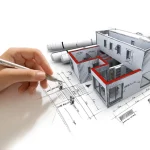The following is a brief introduction to the topic:
Architecture is more than just buildings. It’s a story about cultures, civilisations, and the future we envision. In 2025, architecture will be at the heart of many of the biggest global questions.
- How can we build sustainably?
- How can we design both for beauty and functionality?
- Can smart buildings improve human well-being?
This article examines how it will evolve by 2025, creating smarter, greener and more human-centred environments.
1. Sustainability is no longer optional — it’s foundational
By 2025, the best architectural design will be environmentally conscious by default.
Sustainable practices for 2025:
- Passive design reduces energy consumption (natural lighting, ventilation)
- Use of materials that are carbon negative, such as hempcrete or mycelium bricks
- Integrating solar cells with green roofing and rainfall systems
- Local materials that are recyclable and have a lower carbon footprint than imported or synthetic materials
Global example: Singapore CapitaSpring tower – a vertical urban tree that grows and cools itself.
2. Smart Architecture Meets AI & Automation
The technology is embedded into the building, not just an add-on.
Smart architecture features 2025
- Buildings that use AI sensors to adjust temperature, lighting, and airflow
- Real-time energy use dashboards
- Smart glass auto-tints according to sunlight
- Integrating IoT Systems to improve security, utilities and maintenance
Trend: Homes that have voice-controlled lights, adaptive spaces and real-time feedback on air quality are becoming the norm.
3. Human-Centred Design Is Redefining Urban Spaces
The best cities aren’t built for cars, corporations or even for people. They’re made for.
Design Priorities for 2025
- Mixed-use communities and walkability
- All-inclusive spaces for people of all ages, abilities and backgrounds
- Biophilic Design — Integrating nature into interiors and outer spaces
- Mental health-conscious architecture (natural light, green zones, quiet spaces)
For example, the “15-Minute City Plan” of Paris shows that you can get everything within a few minutes by walking or biking.
4. Revival of Traditional & Vernacular Techniques
Modern architects are returning to ancient knowledge in order to solve their modern problems.
Trends for traditional design in 2025
- Keep cool in your courtyard home without AC
- Natural and breathable: Lime plasters, mud walls and terracotta tile
- Ornaments, patterns and forms inspired by local culture
- Regional designs that are earthquake-resistant and climate resilient
Example: Rammed earth and compressed-mud blocks replace concrete in many ecovillages.
5. Fluid, Flexible Spaces
After the pandemic, people will expect environments that can adapt to their different needs—work, wellness, and learning.
2025 ideas:
- Modular furniture, walls and other structures
- Folding partitions for rooms and transformable rooms
- Rooftop and outdoor working zones
- Interiors that change according to the time of day and season
Hot trend: Studio apartment that can “morph” from bedroom to office, gym and lounge by using smart partitions.
6. Digital Architecture: The Rise of AR/VR in Design
The technology revolutionises how buildings can be imagined and experienced.
Innovations:
- VR Walkthroughs For Clients and City Planners
- AI-assisted drafting using tools such as Midjourney, Rhino, and Revit
- The 3D printing process is used to create scale models of real buildings.
- AR overlays for precision during construction
Architects in 2025 are part-designer, part-technologist, and part-environmentalist.
7. Signature Aesthetics of 2025
The architecture of this year combines simplicity and soul.
Visual Trends
- Arches, soft curves and organic shapes
- Earthy materials such as bamboo, terracotta and wood
- Natural colour palettes (olive, clay, beige, charcoal)
- Large windows, open courtyards, and indoor gardens
Philosophie: Comfort and calm over cold concrete minimalism.
Conclusion: The Future Is Already Being Built
In 2025, architecture will not only be about “what” and “why” but also who is building it.
We are witnessing a shift in the global economy:
- From ego-driven landmarks to eco-driven communities
- From steel skyscrapers to smart and sustainable shelters
- From isolated buildings to connected human habitats
The architects of the next decade will be not only designers but visionaries who will shape how we feel and live.





